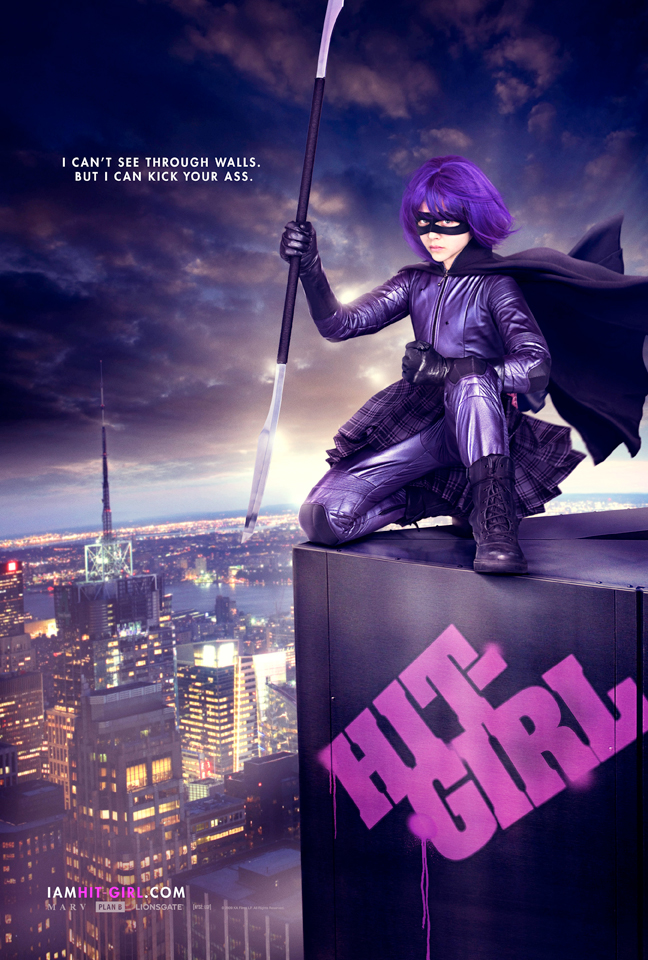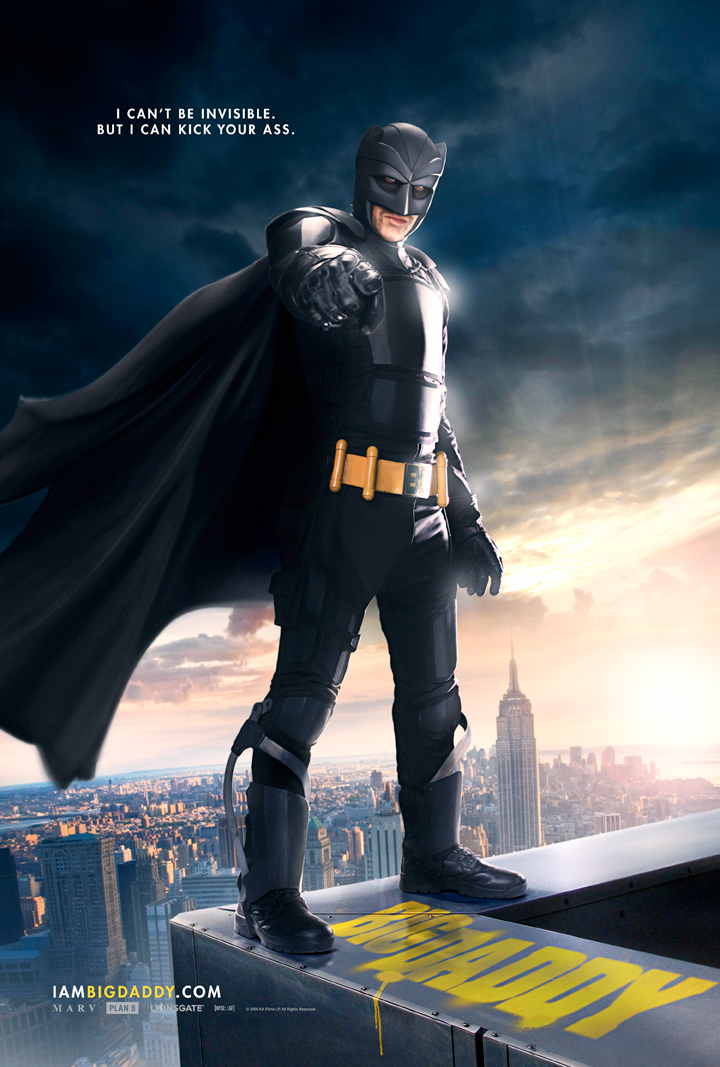By Robert Sims, Special to TheMovieKit.com
 The world hasn’t known a superhero like Kick-Ass.He can’t fly. He can’t climb walls. He can’t turn invisible.
The world hasn’t known a superhero like Kick-Ass.He can’t fly. He can’t climb walls. He can’t turn invisible.
What can he do? Throw a punch. Just about.
High school geek Dave Lizewski (Aaron Johnson) may not possess any superpowers, but that doesn’t stop him from fighting crime. Night after night, though, his costumed alter ego and YouTube star Kick Ass is more likely to end up bruised and bloodied than the crooks and thugs he hunts. So he teams up with two other masked crusaders — Big Daddy (Nicolas Cage) and his sweet but deadly 11-year-old daughter Hit-Girl (Chloë Grace Moretz) — to bring down mobster Frank D’Amico (Mark Strong). Throw in D’Amico’s son Chris (Christopher Mintz-Plasse), who takes on the persona of Red Mist to deceive and defeat his father’s enemies, and Kick-Ass lives up to its name time and time again.
Both a celebration and spoof of the superhero genre, Kick-Ass is the creator of two comic-book icons, Wanted writer Mark Millar and illustrator John Romita Jr. They had barely started work on the Marvel-published series when Layer Cake and Stardust director Matthew Vaughn decided to give Kick-Ass the Spider-Man treatment.
In advance of Kick-Ass’s April 16 opening, the British director, the Scottish writer and the American illustrator premiered their cheerfully violent and decidedly unconventional superhero saga at SXSW. The day after the premiere, the three gathered—along with most of the cast — to discuss the origin of Kick-Ass, the differences between the comic book and the film, and the reaction to Moretz playing a foul-mouthed one-preteen army.
Step 1: Unleash Your Inner Superhero
Mark Millar: “It was very autobiographical. Like when I was 15 my best friend and I were reading Frank Miller comics like Batman: Year One… We were so into it we should have been studying for our O Levels, our exams, at the time. We said, ‘Let’s start going to the gym, let’s start learning karate, and let’s start being superheroes.’ It was that pathetic. We were five years too old to be doing this. And we really got into it. The story is really about what would have happened if we hadn’t come to our senses, that we had actually gone out and done this. It’s funny, because the character I created is called Mr. Danger, and I thought it was a cool look and design. My friend’s idea was Batman. It was Batman’s exact costume. I said, ‘You haven’t put a lot of thought into this at all. If D.C. gets wind of this you’re fucked.’ He was like, ‘They’ll never know. They don’t know who’s under the mask.’ And it was a good point.”
Step 2: Find the Right Sidekick
Millar: “About three years ago Matthew was going to be doing Thor, and it didn’t quite work out. He was just looking for a new project, and we have a mutual friend who thought, ‘You guys would get on well.’ We have a phone call that about lasted four hours. Normally, a first phone with someone, it’s a couple of minutes. But we talked all afternoon about these all geek things we were into, and we both thought it would be quite nice to work on something together. Matthew asked, ‘What have you got?’ He was looking at a few items, a few potential projects, and I had a thing called American Jesus which was a sequel to the Bible…. Matthew and I talked about that briefly, and I mentioned informally that I had started writing a thing called Kick-Ass, and I had only written two issues and I was working on the third. He said, ‘Can you send it down?’ He read it, he liked it, and he said, ‘Can you finish the third? I’d like to see it.’ I sent it down. He said, ‘Where’s the fourth?’ I said, “Can you give me a week?’ So I wrote it and sent it down, and he said, “Where’s the fifth one?’ I said, “I can’t do this.’ He said, “Do you mind if I move on from here?’ It’s weird, it was so informal, there were no agents [involved]…. It was just two mates sitting informally, saying, “Let’s do something together.’ So Matthew went off and did a draft of the screenplay, I had various notes, I had written a bit of issue six, and Matthew brought all this new stuff. It was really cool. The best bits, I nicked [stole] and then put back in the book, which was great. Before we knew it, a screenplay emerged. And Jane Goldman came in and did another draft—magnificent—we thought this is the Pulp Fiction of superhero movies. We thought was awesome, but everyone else thought it was shit. They hated it. Every studio knocked it back.”
Matthew Vaughn: “I wanted to make a post-modern superhero movie. After looking at Thor and X-Men 3, and all the other scripts I read, they all just felt, you could change the superhero characters and the film would be virtually identical. It was just a different baddie and a different goodie. I just wanted to try to create the feeling I had when I first saw the comic-book movie. I was like, ‘Wow!’ When I read the Kick-Ass one—I can’t even remember our phone call to be honest…”
Millar: “You may have hung up three hours earlier.”
Vaughn: “I might have, as you can tell by his long answers. But it just felt like the right time to do. I was getting bored of the Hollywood bullshit. I thought it was time to do something independent and different.”
 Step 3: Don’t Be Watchman-Faithful to Your Source Material
Step 3: Don’t Be Watchman-Faithful to Your Source Material
Millar: “We had something hammered out but as I was writing the comic after Matthew had finished the screenplay I realized the episodic nature of comics means that I had an eight-act story really and there had to be reveals and twists that would have messed up the structure of the movie. So things like Big Daddy’s big reveal would have been awful in the movie if it had gone that way, so they kept the original back-story for Big Daddy… It’s only one page of the comic book but it turns everything on its head and would have just ruined the movie. Likewise, the jetpack scene wouldn’t have worked in the comic. In the movie, things were building up so much at that point you need some ‘Luke Skywalker blowing up the Death Star’ moment. It was only two or three real diversions it took but it was necessary. Whenever someone slavishly adapts a graphic novel it can be quite tedious. First and foremost, I think the guys were just trying to make a good movie.”
John Romita Jr.: “It’s a kinetic thing. With the comics, it’s stop action. So you can have them come up an elevator and still do it fine visually but you can’t that type of stop action with film. You have to have that kinetic movement. The jetpack had to be done that way.”
Step 4: Declare Your Independence
Vaughn: “All the studios said no. It was a totally independent film. We couldn’t get any of shall we say the more safe places of raising finances for movies. The studios that were intrigued by it said that, ‘We’ll do it if you get rid of Hit-Girl and it make it as a PG.’ I was like, ‘No.’ Luckily enough, I’m sorta connected to — I made a lot of independent films before I made studio movies so I raised the money. It was pretty easy. I was lucky.”
Romita Jr.: It’s got to be so satisfying, knowing that after it’s all said and done, they came crawling back to you. I think that’s fantastic. That’s a testament to Matthew.”
Vaughn: “They didn’t crawl, but …”
Step 5: Stare Down the Moral Majority
Vaughn: “As long as they’re not reporting that someone’s gone and copied what they do in the movie, I’ll be fine with them complaining and causing controversy. I personally feel — I’ve been asked this question a lot and I don’t want to answer it without sounding bored… I think it’s really important that if you’re going to criticism a movie, or say this is morally wrong, go see it and then I’ll listen to your opinion. If you haven’t seen it, I’m not really that interested. I’m not forcing someone to buy a ticket to this film.”
Step 6: It’s OK to Be Sensitive
Vaughn: “When Mark first saw the film, his first comment to me was, ‘You’ve gone and made a chick flick out of this film.’ I think he meant that. I think the difference between us is that he’s Scottish, so he’s a bit colder, I’m English and a bit warmer.”
Millar: “A lot of people think it’s quite a violent, dark cynical film, but when you look at it look at it the poster’s all primary colors and in a way it’s the most naïve and idealistic movie I’ve seen in years. It’s about a wee guy who every night could get killed. Spider-Man’s probably going to be all right. Superman’s fine. His movie sucked, but he’s fine. But Kick-Ass at any moment can take a bullet. Even one guy giving him a bad punch to his throat and he’s dead. And it’s so apparent when I was watching it last night [at SXSW] that when he was fighting those three guys outside the diner and you think there’s something so nice about it, that he’s waiting until the cops get there. It’s quite a sweet movie.”
Step 6: Appreciate Your Good Fortune
Millar: “I wrote a comic book about four years called Wanted that was an Angelina Jolie movie last year. What they did with that, the first 58 minutes was the book and then they did their own thing. For those who have seen the movie, it’s all that stuff with the Fate of Loom [Loom of Fate] or whatever. Then they went back to being the book again for the final 10 minutes. I thought that’s just what happens. The studio system, they chew your thing up and hopefully do a good job. Timur [Bekmambetov] luckily did but it could have gone so horribly wrong. First I first saw the script I went, ‘Oh, my God.’”
“To work out like that, with the first two books being turned into movies by two guys at the top of their game, it’s just incredible luck. I should have a whole bunch of shit movies before I got to one good one surely. So I’m really pleased. I’ve been kinda spoiled now… Because there’s good buzz on both movies, other books that I’ve done people are circling and talking to me about them. You just have to be careful. Once you have had two good guys work with you, you want to make sure the next guy’s good, too. You don’t want to just take the check. I don’t know where I’ll go from here. I’m not sure who else will meet this standard.”


One thought on “How to Interview: “Kick-Ass” Without Getting Your Ass Kicked, Part 1”
Comments are closed.